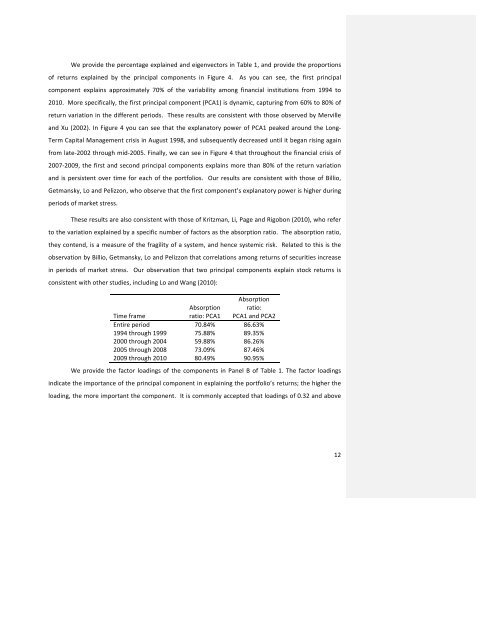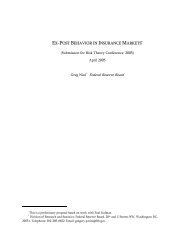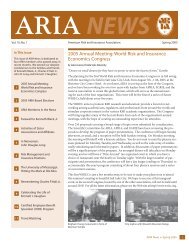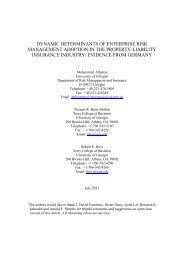Insurance and Interconnectedness in the Financial Services Industry
Insurance and Interconnectedness in the Financial Services Industry
Insurance and Interconnectedness in the Financial Services Industry
You also want an ePaper? Increase the reach of your titles
YUMPU automatically turns print PDFs into web optimized ePapers that Google loves.
We provide <strong>the</strong> percentage expla<strong>in</strong>ed <strong>and</strong> eigenvectors <strong>in</strong> Table 1, <strong>and</strong> provide <strong>the</strong> proportions<br />
of returns expla<strong>in</strong>ed by <strong>the</strong> pr<strong>in</strong>cipal components <strong>in</strong> Figure 4. As you can see, <strong>the</strong> first pr<strong>in</strong>cipal<br />
component expla<strong>in</strong>s approximately 70% of <strong>the</strong> variability among f<strong>in</strong>ancial <strong>in</strong>stitutions from 1994 to<br />
2010. More specifically, <strong>the</strong> first pr<strong>in</strong>cipal component (PCA1) is dynamic, captur<strong>in</strong>g from 60% to 80% of<br />
return variation <strong>in</strong> <strong>the</strong> different periods. These results are consistent with those observed by Merville<br />
<strong>and</strong> Xu (2002). In Figure 4 you can see that <strong>the</strong> explanatory power of PCA1 peaked around <strong>the</strong> Long-‐<br />
Term Capital Management crisis <strong>in</strong> August 1998, <strong>and</strong> subsequently decreased until it began ris<strong>in</strong>g aga<strong>in</strong><br />
from late-‐2002 through mid-‐2005. F<strong>in</strong>ally, we can see <strong>in</strong> Figure 4 that throughout <strong>the</strong> f<strong>in</strong>ancial crisis of<br />
2007-‐2009, <strong>the</strong> first <strong>and</strong> second pr<strong>in</strong>cipal components expla<strong>in</strong>s more than 80% of <strong>the</strong> return variation<br />
<strong>and</strong> is persistent over time for each of <strong>the</strong> portfolios. Our results are consistent with those of Billio,<br />
Getmansky, Lo <strong>and</strong> Pelizzon, who observe that <strong>the</strong> first component’s explanatory power is higher dur<strong>in</strong>g<br />
periods of market stress.<br />
These results are also consistent with those of Kritzman, Li, Page <strong>and</strong> Rigobon (2010), who refer<br />
to <strong>the</strong> variation expla<strong>in</strong>ed by a specific number of factors as <strong>the</strong> absorption ratio. The absorption ratio,<br />
<strong>the</strong>y contend, is a measure of <strong>the</strong> fragility of a system, <strong>and</strong> hence systemic risk. Related to this is <strong>the</strong><br />
observation by Billio, Getmansky, Lo <strong>and</strong> Pelizzon that correlations among returns of securities <strong>in</strong>crease<br />
<strong>in</strong> periods of market stress. Our observation that two pr<strong>in</strong>cipal components expla<strong>in</strong> stock returns is<br />
consistent with o<strong>the</strong>r studies, <strong>in</strong>clud<strong>in</strong>g Lo <strong>and</strong> Wang (2010):<br />
Absorption<br />
Absorption<br />
ratio:<br />
Time frame<br />
ratio: PCA1 PCA1 <strong>and</strong> PCA2<br />
Entire period 70.84% 86.63%<br />
1994 through 1999 75.88% 89.35%<br />
2000 through 2004 59.88% 86.26%<br />
2005 through 2008 73.09% 87.46%<br />
2009 through 2010 80.49% 90.95%<br />
We provide <strong>the</strong> factor load<strong>in</strong>gs of <strong>the</strong> components <strong>in</strong> Panel B of Table 1. The factor load<strong>in</strong>gs<br />
<strong>in</strong>dicate <strong>the</strong> importance of <strong>the</strong> pr<strong>in</strong>cipal component <strong>in</strong> expla<strong>in</strong><strong>in</strong>g <strong>the</strong> portfolio’s returns; <strong>the</strong> higher <strong>the</strong><br />
load<strong>in</strong>g, <strong>the</strong> more important <strong>the</strong> component. It is commonly accepted that load<strong>in</strong>gs of 0.32 <strong>and</strong> above<br />
12






